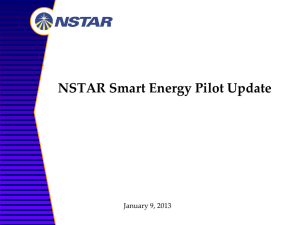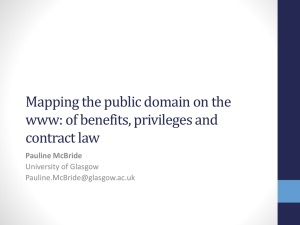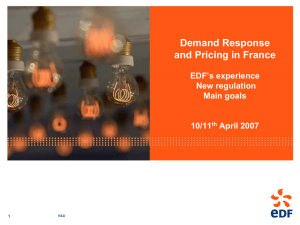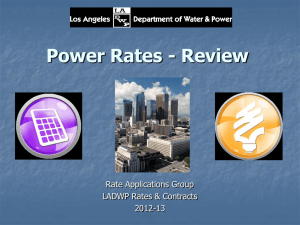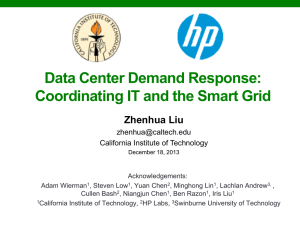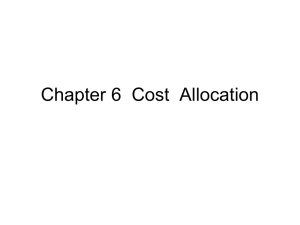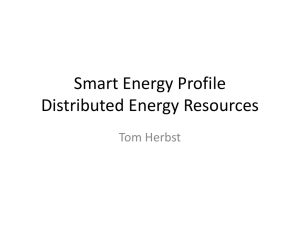Presentation - Ontario Energy Board
advertisement
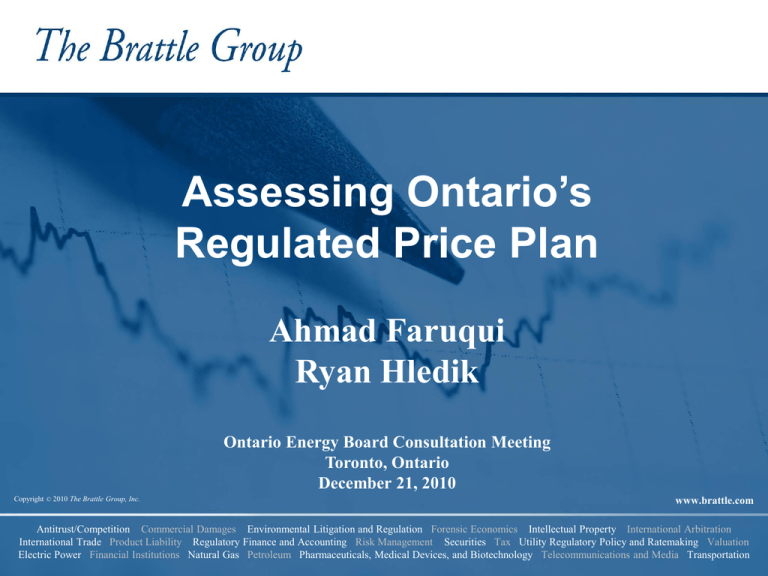
Assessing Ontario’s Regulated Price Plan Ahmad Faruqui Ryan Hledik Ontario Energy Board Consultation Meeting Toronto, Ontario December 21, 2010 Copyright © 2010 The Brattle Group, Inc. www.brattle.com Antitrust/Competition Commercial Damages Environmental Litigation and Regulation Forensic Economics Intellectual Property International Arbitration International Trade Product Liability Regulatory Finance and Accounting Risk Management Securities Tax Utility Regulatory Policy and Ratemaking Valuation Electric Power Financial Institutions Natural Gas Petroleum Pharmaceuticals, Medical Devices, and Biotechnology Telecommunications and Media Transportation The logic of Time-of-Use (TOU) pricing Generation costs vary by pricing period but this variation is masked by non-TOU rates, thereby creating an unintended inequity Under non-TOU rates, customers who don’t consume much during peak periods pay more than their fair share of costs and those who consume much during peak periods pay less than their fair share By reflecting this time-variation in costs, TOU rates eliminate an important unfairness in rate design Additionally, by lowering rates during the off-peak period and raising them during the peak period, TOU rates provide customers an opportunity to reduce their monthly bills by curtailing consumption during peak periods and/or shifting it to off-peak periods These benefits have been demonstrated consistently across a broad range of studies carried out in North America, Europe and Australia which have found that about 75 percent of customers are better off with TOU rates OEB Consultation Meeting 2 We explored the merits of alternative TOU design options in Ontario Overview of Project Approach Step 1: Review Existing TOU Rate Step 2: Identify Areas for Improvement Step 3: Establish Alternatives Step 4: Evaluate the Alternatives Define rate evaluation criteria Benchmark rate against industry best practices Peak-to-off-peak price ratio is too small Identify aspects of TOU that can be modified Review TOU impact evaluation studies Expected range of bill impacts not fully understood Modify aspects of TOU design to create attractive alternative rate options Simulate expected rate impacts under full deployment OEB Consultation Meeting Further research on rate impacts (pilots) needed Simulate expected impacts of rate options 3 Assess pros and cons of each rate option Summarize rate evaluation and present recommendations Ontario’s transition to TOU pricing is in progress … to a TOU rate TOU Rate Illustration - Electricity Price 0.14 0.14 0.12 0.12 Generation Rate (C$/kWh) Generation Rate (C$/kWh) Transitioning from -the tiered Tiered Rate Illustration Electricity Price rate… 0.10 $0.075 0.08 $0.065 0.06 0.04 Summer Tiered 0.02 $0.099 $0.099 0.10 0.08 $0.080 $0.053 0.06 $0.053 0.04 Summer TOU 0.02 Winter Tiered Winter TOU 0.00 0.00 0 200 400 600 800 1000 1200 1400 1600 0 1 2 3 4 5 6 7 8 9 10 11 12 13 14 15 16 17 18 19 20 21 22 23 24 Monthly Usage (kWh) Hour Starting Currently ~2.8 million enrolled Currently ~1.2 million enrolled Compared to the tiered rate, the TOU provides a discount during the off-peak period (59% of hours) and a higher price in the remaining hours Note: OEB Consultation Meeting Prices represent only the generation component of the rate. 4 The majority of hours are in the low-priced off-peak period, an attractive feature for customers Summer TOU Hour Allocation Winter TOU Hour Types On-peak 774 18% Mid-peak 1032 23% On-peak 1016 23% Off-peak 2610 59% Mid-peak 762 18% There is a larger share of peak hours in the winter than in the summer OEB Consultation Meeting 5 Off-peak 2566 59% Each defining characteristic of the TOU rate was benchmarked against industry best practices Results of Benchmarking TOU Characteristic Alignment with Best Practices? Reason Number of periods Strong Many TOU rates have three periods Timing/duration of peak Strong Aligns well with historical system load and hourly energy market prices Seasonality Strong Dual peak in winter justifies seasonal change in pricing structure Time-varying charges Strong Typically only generation-related charges are made to be time-varying Moderate Calculation is reasonable given available data; focus on province-wide supply cost recovery can have differential impacts on customers Weak Price ratio is low relative to TOU programs in other jurisdictions; likely to produce modest customer response or bill savings Average customer cost neutrality Price ratio OEB Consultation Meeting 6 System load and hourly energy prices align well in shape with the TOU rate $0.12 30,000 $0.12 25,000 $0.10 25,000 $0.10 20,000 $0.08 20,000 $0.08 15,000 $0.06 15,000 $0.06 10,000 $0.04 10,000 $0.04 Load Avg Energy Price (2004-2010) TOU 5,000 - System Load (MW) 30,000 $0.02 $- - 0 1 2 3 4 5 6 7 8 9 10 11 12 13 14 15 16 17 18 19 20 21 22 23 24 Hour Starting Load Avg Energy Price (2004-2010) TOU 5,000 $0 1 2 3 4 5 6 7 8 9 10 11 12 13 14 15 16 17 18 19 20 21 22 23 24 System Load Data from 2009 LMP Data from 2009 Hour Starting There is a fairly broad summer peak and a dual peak in the winter OEB Consultation Meeting $0.02 7 System Load Data from 2009 LMP Data from 2009 Rate (C$/kWh) System Load, LMP, and TOU Rate Average Winter Day Rate (C$/kWh) System Load (MW) System Load, LMP, and TOU Rate Average Summer Day The peak-to-off-peak price ratio is low relative to TOU rates elsewhere Distribution of Price Ratios in Existing TOU Rates (Generation Only) Distribution of Price Ratios (Peak / Off Peak) in Existing TOU Programs 16 RPP TOU Price Ratios All-in: 1.4 to 1.2 to 1 Number of TOU Programs Generation Only: 1.9 to 1.5 to 1 14 RPP TOU ratio = 1.9 12 Mean ratio = 3.8 10 8 6 4 2 0 0 1 2 3 4 5 6 7 8 Price Ratio (Peak / Off Peak) Note: Excludes II" which ratio of 29 1. Note:ConEdison Details Residential on each"Rate TOU rate has area price provided in tothe appendix This ratio could be adjusted to better reflect system conditions OEB Consultation Meeting 8 9 10 11 There are many ways to increase the price ratio Rate Design Option In Existing TOU… Alternative option… Likely Impact on Price Ratio Renewables Cost Reallocation Existing GA costs only, allocated uniformly across periods Allocate wind & solar to peak period, account for expected FIT costs Increases peak costs, decreases off-peak costs, and increases price ratio Peak Duration 6 hour peak, 8 hour mid-peak (opposite in non-summer months) Shorten peak and midpeak period to 4 hours in both seasons Shorter peak period spreads capacity costs over fewer peak hours, increasing the peak price Seasonality Year-round Summer-only TOU with off-peak rate applying during the winter months Summer-only means fewer peak hours and therefore higher peak price Price setting methodology Set off-peak and midpeak price, solve for peak price Set peak and mid-peak price, solve for off-peak price Changes in the supply cost structure could increase or decrease the price ratio under this approach Number of periods Three periods (peak, mid-peak, and off-peak) Remove mid-peak period to create 2 period rate Depends on how prices are set; combined with other rate design approaches, smaller number of periods could be beneficial OEB Consultation Meeting 9 Collectively, these changes could produce a price ratio of 4.9:1, while an alternate approach could lead to a 4.1:1 ratio Price Ratios with Incremental Changes to Rate Design Generation-only Peak to Off-Peak Price Ratio 6 4.9 5 4.1 4 3.2 3 2.7 1.9 2 1 0 Existing TOU Reallocation of Wind/Solar GA Cost 4 Hour Peak Period Summer Only Alternative Peak Price, 2 Periods Note: Impact on price ratio is cumulative as shown in figure; incremental impacts of each change to the design would be different if implemented individually OEB Consultation Meeting 10 The results of TOU pilots in Ontario can be used to predict customer response to the new rate designs TOU pricing was tested in five Ontario pilots ♦ Newmarket Hydro ♦ Hydro One ♦ Hydro Ottawa ♦ Oakville Hydro ♦ Veridian Connections TOU enrollment in the pilots ranged from 40 to 180 participants (although one pilot was just 3 commercial buildings) Treatment periods were in the 2006 to 2007 timeframe, with pilot durations lasting from 5 months to slightly over 1 year See Appendix A for details on the pilots OEB Consultation Meeting 11 The pilots are moderately applicable for extrapolation of TOU impacts at the province level Applicability of Pilot Results for Province-Wide Assessment Applicability of Results Reason High TOU results are relevant and impacts cover full summer season Newmarket Hydro Medium TOU results are relevant, but sample size is small (39 participants) Hydro Ottawa (OSPP) Medium Relevant TOU results, but not statistically significant and impacts only reported for critical days Oakville Hydro Low Short period of pre-treatment data collection, very limited and unrepresentative sample of only 3 buildings Veridian Connections Low Only includes bulk-metered customers >200 kW Utility Hydro One Based on this screening, we have selected the Hydro One, Newmarket Hydro, and Hydro Ottawa pilots for more detailed analysis OEB Consultation Meeting 12 The results from the 3 most relevant pilots were benchmarked against informed expectations Comparison of Peak Impacts Across Pilots Calibrated Impacts from Other Pilots Connecticut California Maryland Impacts from Ontario Pilots Newmarket Hydro Hydro Ottawa Hydro One Change in Demand During Peak Period 0.0% -0.4% -1.0% -1.2% -2.0% -1.8% -2.3% -2.4% -3.0% -4.0% -5.0% -3.7% ♦ Peak impacts from the Ontario pilots align fairly well with expectations from other pilots around North America ♦ The other North American pilot impacts were calibrated to the price ratio of the RPP TOU rate and Ontario’s system conditions Notes: (1) The impact evaluations conducted by Oakville Hydro and Veridian Connections were excluded due to lack of applicability of results or statistically insignificant impacts. (2) “Other pilot” impacts are calibrated roughly to the rates tested in the Ontario 13 pilots; results would vary slightly depending on which Ontario pilot rates they are being calibrated to, although this variation is not enough to produce any significant difference in the impacts (roughly +/- 0.1%) OEB Consultation Meeting There is significant variation in overall energy consumption impacts across the pilots ♦ This variation is partly Comparison of Energy Consumption Impacts Across Pilots Calibrated Impacts from Other Pilots Connecticut California Maryland 0.3% 0.4% Change in Usage During Study Period 2.0% 1.0% Impacts from Ontario Pilots Newmarket Hydro Hydro One Hydro Ottawa 1.1% 0.4% 0.0% -1.0% -2.0% -3.0% -4.0% -3.3% -5.0% -6.0% -6.0% -7.0% explained by Ontario pilot limitations (short pilot durations spanning different time periods, often with a small number of participants) ♦ Also explained by lack of average customer cost neutrality at the utility level (customers experience change in rate level when moving from existing tiered rate to TOU) ♦ This highlights the need for better understanding of the impact of the TOU rate in Ontario Notes: (1) The impact evaluations conducted by Oakville Hydro and Veridian Connections were excluded due to lack of applicability of results or statistically insignificant impacts. (2) “Other pilot” impacts are calibrated roughly to the rates tested in the Ontario 14 pilots; results would vary slightly depending on which Ontario pilot rates they are being calibrated to, although this variation is not enough to produce any significant difference in the impacts (roughly +/- 0.1%) OEB Consultation Meeting Implied elasticities from the Ontario pilots were integrated into Brattle’s Price Impact Simulation Model (PRISM) The PRISM Modeling Framework Model Inputs Customer’s peak period usage Customer’s off-peak period usage All-in peak price of new rate All-in off-peak price of new rate Central air-conditioning saturation Weather Basic Drivers of Impacts Load Shape Effects Peak-to-off-peak usage ratio Peak-to-off-peak price ratio Substitution effect (i.e. load shifting) Overall change in load shape (peak and off-peak by day) Elasticity of substitution Geographic location Customer class (e.g. residential, C&I) Load-wtd avg daily allin price of new rate Existing flat rate OEB Consultation Meeting Aggregate Load Shape and Energy Consumption Impact Daily price elasticity Daily effect (i.e. conservation or load building) Difference between new rate (daily average) and existing flat rate 15 Our PRISM analysis relied on three elasticity scenarios Lower-bound elasticity assumption: ♦ Roughly tied to results of the Newmarket Hydro pilot ♦ 0.5% peak reduction at 3-to-1 price ratio, with little conservation effect Upper-bound elasticity assumption: ♦ Roughly tied to results of Hydro One pilot ♦ 3% peak reduction at 3-to-1 price ratio, but with smaller conservation effect “Base Case” elasticity assumption: ♦ Average of “low” and “high” elasticities ♦ Aligns with range of simulated impacts from other North American studies OEB Consultation Meeting 16 Four alternative TOU rate designs were developed based on our findings Alternative TOU Description Price ratio Rate #1: Wind/solar reallocation The existing TOU with the addition and reallocation of expected wind and solar GA costs to the peak period 2.7-to-1 Rate #2: Wind/solar reallocation + 4-hour peak Rate #1 but also with peak and mid-peak windows reduced to four hours 3.2-to-1 Rate #3: Wind/solar reallocation + 4-hour peak + summer only Rate #2 but also with TOU rate limited to summer months (May through October); flat rate applies other months 4.9-to-1 Rate #4: Alternative peak price + 2 period Peak price set equal to average peak energy price plus levelized cost of capacity ($100/kW-yr); off-peak solved for cost neutrality; summer only with 4 hour peak period 4.1-to-1 See Appendix B for details of these four alternative rate designs OEB Consultation Meeting 17 The average peak impacts of the four rate alternatives range from 1% to 4% and could be as high as 7% Range of Average RPP Customer Response by Rate Alternative Range of Average RPP Customer Response Projections 8% 7% Peak Reduction 6% Range represents impacts from "high" and "low" response estimates 5% 4% 4.0% 3.3% 3% 2% 2.0% 1.4% 1% 0.9% 0% Existing TOU Rate #1: Wind/Solar Reallocation Rate #2: Reallocation + 4-hr Peak Rate #3: Reallocation + 4-hr Peak + Summer-only Rate #4: Alternative Price + 2-period Elasticity assumptions based on the range of reasonable elasticities derived from a review of the existing Ontario impact studies and supplemented by the results of other time-based pricing studies; For the midpoint, elasticity of substitution = -0.03 and daily elasticity = -0.11 OEB Consultation Meeting 18 The rates will impact each customer differently depending on their consumption profile Three Illustrative Customer Consumption Profiles 3.5 "Peaky" customer Hourly Electricity Usage (kW) 3.0 2.5 "Average" customer 2.0 "Flat" customer 1.5 1.0 0.5 0.0 1 2 3 4 5 6 7 8 9 10 11 12 13 14 15 16 17 18 19 20 21 22 23 24 Hour of Day OEB Consultation Meeting 19 ♦ “Flat” usage customers will experience bill savings due to low consumption in the higher-priced periods ♦ The opposite is true for “peaky” usage customers ♦ Bill impacts have been estimated for a representative sample of roughly 500 utility customers that fall at various points along the spectrum of “flat” and “peaky” usage Across samples from 5 utilities, changes in customer bills will range from -12% to +18% Distribution of Bill Impacts for Rate #3 (Before Response) 20% Toronto Hydro Generation-Only Bill Change (%) 15% 10% Avg bill increase 5% 0% -5% Avg bill decrease -10% -15% -20% 0% 10% 20% 30% 40% 50% 60% 70% 80% 90% 100% Percentile Note: Results shown for Rate #3 before any customer response and are relative to today’s TOU OEB Consultation Meeting 20 Across samples from 5 utilities, changes in customer bills will range from -12% to +18% Distribution of Bill Impacts for Rate #3 (Before Response) 20% Thunder Bay 15% Generation-Only Bill Change (%) Toronto Hydro 10% Avg bill increase 5% 0% -5% Avg bill decrease -10% -15% -20% 0% 10% 20% 30% 40% 50% 60% 70% 80% 90% 100% Percentile Note: Results shown for Rate #3 before any customer response and are relative to today’s TOU OEB Consultation Meeting 21 Across samples from 5 utilities, changes in customer bills will range from -12% to +18% Distribution of Bill Impacts for Rate #3 (Before Response) 20% Newmarket Thunder Bay 15% Generation-Only Bill Change (%) Toronto Hydro 10% Avg bill increase 5% 0% -5% Avg bill decrease -10% -15% -20% 0% 10% 20% 30% 40% 50% 60% 70% 80% 90% 100% Percentile Note: Results shown for Rate #3 before any customer response and are relative to today’s TOU OEB Consultation Meeting 22 Across samples from 5 utilities, changes in customer bills will range from -12% to +18% Distribution of Bill Impacts for Rate #3 (Before Response) 20% PowerStream Newmarket Thunder Bay Toronto Hydro Generation-Only Bill Change (%) 15% 10% Avg bill increase 5% 0% -5% Avg bill decrease -10% -15% -20% 0% 10% 20% 30% 40% 50% 60% 70% 80% 90% 100% Percentile Note: Results shown for Rate #3 before any customer response and are relative to today’s TOU OEB Consultation Meeting 23 Across samples from 5 utilities, changes in customer bills will range from -12% to +18% Spread Renewables TOU with Today's Relative to for Impacts Estimated Distribution ofBillBill Impacts Rate #3Evenly (Before Response) Today's TOU w/ Renewables and 4 Hour Peak - Summer Only 20% PowerStream Newmarket Thunder Bay Toronto Hydro Milton Hydro Generation-Only Bill Change (%) 15% 10% Avg bill increase 5% 0% -5% Avg bill decrease -10% -15% -20% 0% 10% 20% 30% 40% 50% 60% 70% 80% 90% 100% Percentile Note: Results shown for Rate #3 before any customer response and are relative to today’s TOU OEB Consultation Meeting 24 After customers shift consumption, a higher percentage will experience bill savings Estimated Bill Impacts Relative to Today's TOU with Evenly Spread Renewables Today's TOU w/ Renewables and 4 Hour Peak - Summer Only Bill Impacts Before and After Customer Response 10% Bill impact before customer response 8% Bill impact after customer response ("high" case) Generation-Only Bill Change (%) 6% 4% 2% 0% -2% Customer response results in greater bill savings and a larger share of customers with an incremental bill decrease -4% -6% -8% -10% 0% 10% 20% 30% 40% 50% 60% 70% 80% 90% 100% Percentile Note: Results shown for Rate #3 for Toronto Hydro sample; see Appendix C for full results OEB Consultation Meeting 25 The aggregate response of 4 million customers on the TOU rate will lower peak demand and ultimately contribute to a reduction in generation costs, helping all Ontarians IESO Load Duration Curve with Rate #3 Impact 25,000 24,500 Reduction in system peak due to largest simulated TOU impact = 4% (1,064 MW) System Load (MW) 24,000 23,500 23,000 22,500 22,000 21,500 21,000 System Load without TOU 20,500 System Load with Largest Projected TOU Impact 20,000 0 50 100 Top 200 Hours OEB Consultation Meeting 26 150 200 In other rate scenarios, peak demand declines from a low of 0.2% to a high of 4.4% IESO System Peak Demand Impacts by Rate Scenario Low Response Moderate Response High Response % MW % MW % MW Rate #1: Wind/solar reallocation 0.2% 61 1.0% 234 1.7% 405 Rate #2: Renewables reallocation + 4-hour peak 0.4% 101 1.4% 335 2.3% 566 Rate #3: Renewables reallocation + 4-hour peak + summer-only 0.7% 160 2.8% 676 4.4% 1,064 Rate #4: Alternative peak price + 2 period 0.7% 159 2.1% 510 2.8% 674 OEB Consultation Meeting 27 The Path Forward If the top priority is to… Then the OEB could… But be aware… Minimize the implementation burden Continue with the current design and simply reallocate renewables costs to the peak period This only marginally improves the price ratio Improve the price ratio Consider significant rate design changes that decrease the number of peak hours (such as seasonality and a shorter peak period) Significant design changes will require re-education of utilities, policymakers, and customers regarding the new rate structure Simplify the rate-setting process Pursue an alternative approach where the peak period price is pegged to marginal capacity and energy costs, and the off-peak is solved for revenue neutrality This would require a major overhaul of the current methodology and would require significant research to determine the appropriate marginal cost assumptions Better understand customer responsiveness Conduct an impact assessment of customer consumption behavior after the full transition to the TOU rate While this option carries little risk, alone it does not lead to greater customer response rates Improve customer response and perception Work with utilities to initiate an education campaign around the rate and its benefits, possibly including the provision of enabling technologies Customer education improves response but cannot lead to greater bill savings if the rate design does not offer the opportunity to significantly reduce bills Combinations of these approaches could achieve balance across priorities, but would be more complex OEB Consultation Meeting 28 Ahmad Faruqui Ahmad Faruqui provides expert advice on time-of-use and dynamic pricing to utilities and government agencies. He has testified on rate design issues before a dozen state and provincial commissions and legislative bodies and spoken at a wide variety of energy conferences in Brazil, Canada, France, Ireland, Saudi Arabia, the United Kingdom and the United States. During the past two years, he has assisted FERC in the development of the “National Action Plan on Demand Response” and in writing “A National Assessment of Demand Response Potential.” He co-authored EPRI’s national assessment of the potential for energy efficiency and EEI’s report on quantifying the benefits of dynamic pricing. He has assessed the benefits of dynamic pricing for the New York Independent System Operator, worked on fostering economic Demand Response for the Midwest ISO and ISO New England, reviewed demand forecasts for the PJM Interconnection and assisted the California Energy Commission in developing load management standards. His most recent report, “The Impact of Dynamic Pricing on Low Income Customers,” has just been published by the Institute for Electric Efficiency. The author, co-author or editor of four books and more than 150 articles, papers and reports, he holds a doctoral degree in economics from the University of California at Davis. OEB Consultation Meeting 29 Ryan Hledik Ryan Hledik is a senior associate of The Brattle Group with specialized expertise in assessing the impacts of smart grid programs, technologies, and policies. He has assisted electric utilities, regulators, research organizations, wholesale market operators, and technology firms in the development of innovative demand response and energy efficiency portfolios and strategies. Recently, Mr. Hledik contributed to the development of the Federal Energy Regulatory Commission’s (FERC) National Assessment of Demand Response Potential, which was submitted to U.S. Congress in June 2009. Mr. Hledik has been the lead developer of several energy market simulation tools for the purposes of wholesale price forecasting, asset valuation, and emissions analysis. Mr. Hledik received his M.S. in Management Science and Engineering from Stanford University in 2006, where his concentration was in Energy Economics and Policy. He received his B.S. in Applied Science (with honors) from the University of Pennsylvania in 2002 with minors in Economics and Mathematics. Prior to joining The Brattle Group, Mr. Hledik was a research assistant with Stanford University’s Energy Modeling Forum and a research analyst at Charles River Associates. OEB Consultation Meeting 30 About The Brattle Group The Brattle Group provides consulting and expert testimony in economics, finance, and regulation to corporations, law firms, and governments around the world. We combine in-depth industry experience, rigorous analyses, and principled techniques to help clients answer complex economic and financial questions in litigation and regulation, develop strategies for changing markets, and make critical business decisions. Climate Change Policy and Planning Cost of Capital Demand Forecasting and Weather Normalization Demand Response and Energy Efficiency Electricity Market Modeling Energy Asset Valuation Energy Contract Litigation Environmental Compliance Fuel and Power Procurement Incentive Regulation Rate Design, Cost Allocation, and Rate Structure Regulatory Strategy and Litigation Support Renewables Resource Planning Retail Access and Restructuring Risk Management Market-Based Rates Market Design and Competitive Analysis Mergers and Acquisitions Transmission ahmad.faruqui@brattle.com 353 Sacramento Street, Suite 1140 San Francisco, CA 94111 OEB Consultation Meeting 31 Appendix A: Current TOU OEB Consultation Meeting 32 Today’s TOU has a 10-hour off-peak period and a price ratio of 1.9 Illustration of Today's TOU Peak Summer Day 32 Today's TOU Generation Rate (cents/kWh) 28 Average Supply Cost (No New Renewables) 24 20 16 Peak to off-peak price ratio = 1.9 12 8 4 0 1 2 3 4 5 6 7 8 9 10 11 12 13 14 15 16 17 18 19 20 21 22 23 Hour Starting OEB Consultation Meeting 33 The seasonal definition lines up with historical IESO load data 2009 IESO System Load ♦ Ontario is mostly a 30,000 System Load (MW) 25,000 20,000 15,000 10,000 5,000 Summer (May – Oct) Jan-09 Feb-09 Mar-09 Apr-09 OEB Consultation Meeting May-09 Jun-09 Jul-09 Aug-09 Sep-09 Oct-09 Nov-09 34 Dec-09 summer peaking region (2004 was last year with winter peak) ♦ However, on average energy use is higher in the winter (by 3% to 9% since 2004), presumably due to electric space and water heating There is a less pronounced seasonal pattern in the historical energy price data 2008 Hourly Ontario Energy Price (HOEP) ♦ Prices are more 600 Summer (May – Oct) System Load (MW) 500 400 300 200 100 Jan-08 Feb-08 Mar-08 Apr-08 May-08 Jun-08 Jul-08 Aug-08 Sep-08 Oct-08 Nov-08 Dec-08 volatile in the summer season ♦ In 2008, the price exceeded $200/MWh in 15 hours, most of which were in the summer (100) Note: 2008 Hourly Ontario Energy Price (HOEP) was used, because it appears to be more representative of the average historical prices than the 2009 HOEP, which was quite low. OEB Consultation Meeting 35 TOU pricing pilots in Ontario Overview of Ontario TOU Pilots Classes of Participants Number of TOU Participants Total Number of Pilot Participants Treatment Period TOU Rate (cents/kWh) Notes Residential 39 220 Aug 06 - Oct 07 P: 9.2 M: 7.2 O: 3.2 Pilot also tested CPR and controllable thermostats Residential, farm, small C&I (<50 kW) 177 500 May 07 - Sep 07 P: 9.7 M: 7.1 O: 3.4 Pilot also tested in-home displays Hydro Ottawa Residential 124 375 Aug 06 - Feb 07 P: 9.7 - 10.5 M: 7.1 - 7.5 O: 3.4 - 3.5 Pilot also tested CPP, CPR, and enabling technolgy Oakville Hydro Multi-res buildings 286 residents in 3 buildings 286 residents in 3 buildings Jan 06 - Oct 07 P: 9.2 - 10.5 M: 7.1 - 7.5 O: 3.2 - 3.5 Pilot primarily tested impact of transition from bulk-metered building to individually metering residents Multi-res and MUSH, all bulk-metered and >200 kW 38 38 Feb 07 - Sep 07 P: 9.2 - 9.7 M: 7.1 - 7.2 O: 3.2 - 3.4 Pilot only focused on TOU rate Utility Newmarket Hydro Hydro One Veridian Connections Notes: “MUSH” is municipals, universities, schools, and hospitals In some pilots the TOU rate changed over time. In this table, the range is provided. OEB Consultation Meeting 36 Appendix B: Alternate TOU Designs OEB Consultation Meeting 37 Rate #1: Today’s TOU with re-allocation (and addition) of renewable GA costs Illustration of Today's TOU w/ Renewables Peak Summer Day 32 Today's TOU w/ Renewables Generation Rate (cents/kWh) 28 Average Supply Cost (With New Renewables) 24 20 Peak to off-peak price ratio = 2.7 16 12 8 4 - 0 1 2 3 4 5 6 7 8 9 10 11 12 13 14 15 16 17 18 19 20 21 22 23 Hour Starting OEB Consultation Meeting 38 ♦ Existing and expected wind & solar GA costs are allocated entirely to the peak period ♦ The peak period price increases, with minor changes to prices in other periods ♦ Alternative allocations could be explored, such as allocating a larger share of hydro costs to the peak period as well ♦ Note that the GA cost associated with new renewables leads to an overall rate increase of 7.5% Rate #2: Today’s TOU with renewable cost reallocation and a four-hour peak period Illustration of Today's TOU w/ Renewables & 4 Hour Peak Peak Summer Day 32 Today's TOU w/ Renewables and 4 Hour Peak Generation Rate (cents/kWh) 28 Average Supply Cost (With New Renewables) 24 Peak to off-peak price ratio = 3.2 20 16 12 8 4 - 0 1 2 3 4 5 6 7 8 9 10 11 12 13 14 15 16 17 18 19 20 21 22 23 Hour Starting OEB Consultation Meeting 39 ♦ The peak and mid-peak duration are decreased to 4 hours each ♦ 25% of peak period GA cost is assumed to be a capacity cost; as such, the absolute cost is spread over the peak hours ♦ As the number of peak and mid-peak hours decreases, the average $/MWh capacity price increases ♦ Note that the 25% estimate for the capacity portion of GA costs is subject to revision Rate #3: Summer-only TOU with renewable cost reallocation and a four-hour peak period Illustration of Today's TOU w/ Renewables & 4 Hour Peak - Summer Only Peak Summer Day Generation Rate (cents/kWh) 32 28 Today's TOU w/ Renewables and 4 Hour Peak - Summer Only 24 Average Supply Cost (With New Renewables) Peak to off-peak price ratio = 4.9 20 16 12 8 4 0 1 2 3 4 5 6 7 8 9 10 11 12 13 14 15 16 17 18 19 20 21 22 23 Hour Starting OEB Consultation Meeting 40 ♦ The TOU rate structure only applies during summer months ♦ The rate is flat during the remaining months of the year (equal to the off-peak price of the summer TOU rate) ♦ The capacity portion of peak GA costs is spread over fewer hours as a result, and the peak price rises Rate #4: The peak price is set based on historical marginal energy and capacity costs Illustration of Marginal Cost-Based Rate (Summer Only) Peak Summer Day 32 Generation Rate (cents/kWh) 28 Marginal Cost-Based Rate Average Supply Cost (No New Renewables) Peak to off-peak price ratio = 4.1 24 20 16 12 8 4 - 0 1 2 3 4 5 6 7 8 9 10 11 12 13 14 15 16 17 18 19 20 21 22 23 Hour Starting OEB Consultation Meeting 41 ♦ The peak price is equal to an average peak energy price of $0.068/kWh plus a capacity price of $100/kWyear, spread across the peak hours ♦ The rate is summer-only ♦ This is a common marginal cost-based approach to TOU rate design that has been adopted by utilities in other parts of North America Appendix C: Summary of Bill Impacts OEB Consultation Meeting 42 Expected Bill Impacts: Commodity Portion Only (Percent) Expected Bill Change for Alternative Rate Options Relative to Existing TOU (Annual Average, Commodity Portion Only) For 10th, 50th, and 90th Percentiles of Customer Bill Impact Distributions Rate Elasticity Case 10th % Rate #1: Reallocation of wind/solar GA costs Rate #2: Reallocation + 4-hour peak Rate #3: Reallocation + 4-hour peak + summer-only Rate #4: Alternative peak price + 2 periods + 4-hour peak + summer only Toronto Hydro 50th % 90th % 10th % Power Stream 50th % 90th % 10th % Thunder Bay 50th % 90th % 10th % Newmarket 50th % 90th % 10th % Milton Hydro 50th % 90th % No Respose -1% 0% 2% -1% 0% 1% -1% 0% 2% -1% 0% 2% -2% 0% 2% Low Respose -1% 0% 1% -1% 0% 1% -1% 0% 2% -1% 0% 2% -2% 0% 2% Moderate Response -2% -1% 1% -2% -1% 1% -2% 0% 1% -2% -1% 1% -2% -1% 1% High Response -2% -1% 0% -3% -1% 0% -3% -1% 1% -2% -1% 0% -3% -1% 1% No Respose -4% 0% 3% -2% 0% 3% -2% 1% 5% -2% 1% 3% -3% 0% 4% Low Respose -4% 0% 2% -3% 0% 3% -2% 1% 4% -2% 1% 3% -3% 0% 3% Moderate Response -4% -1% 2% -3% 0% 2% -3% 1% 4% -3% 0% 2% -4% 0% 3% High Response -5% -2% 1% -4% -1% 1% -4% 0% 3% -4% -1% 2% -5% -1% 2% No Respose -6% -1% 4% -5% 2% 10% -6% 0% 10% -6% 2% 8% -4% 3% 10% Low Respose -6% -1% 4% -5% 2% 9% -6% 0% 9% -6% 2% 8% -4% 3% 9% Moderate Response -6% -2% 3% -6% 1% 8% -6% -1% 8% -7% 1% 7% -5% 2% 8% High Response -7% -3% 2% -6% 0% 7% -7% -2% 7% -7% 0% 5% -5% 1% 7% No Respose -4% -1% 3% -4% 2% 6% -5% 0% 7% -4% 1% 6% -3% 2% 7% Low Respose -4% -1% 3% -4% 2% 6% -5% 0% 7% -5% 1% 6% -3% 2% 7% Moderate Response -4% -2% 2% -4% 1% 5% -6% -1% 6% -5% 0% 5% -4% 2% 6% High Response -5% -2% 2% -4% 1% 5% -6% -1% 6% -5% 0% 4% -4% 1% 5% Notes: Impacts are relative to the current TOU with expected future renewable GA costs included and allocated evenly across the rate periods. Power Stream sample appears to include residential and non-residential customers; the other samples are limited to residential customers. OEB Consultation Meeting 43 Expected Bill Impacts: Commodity Portion Only (Dollar Amount) Expected Bill Change for Alternative Rate Options Relative to Existing TOU (Annual Average, Commodity Portion Only) For 10th, 50th, and 90th Percentiles of Customer Bill Impact Distributions Rate Elasticity Case 10th % Rate #1: Reallocation of wind/solar GA costs Rate #2: Reallocation + 4-hour peak Rate #3: Reallocation + 4-hour peak + summer-only Rate #4: Alternative peak price + 2 periods + 4-hour peak + summer only Toronto Hydro 50th % 90th % 10th % Power Stream 50th % 90th % 10th % Thunder Bay 50th % 90th % 10th % Newmarket 50th % 90th % 10th % Milton Hydro 50th % 90th % No Respose -$5.71 $0.58 $9.02 -$13.09 $0.37 $14.24 -$5.36 $1.58 $9.01 -$5.85 $0.65 $10.72 -$8.91 $0.39 $14.36 Low Respose -$6.13 $0.19 $7.96 -$14.84 $0.02 $12.22 -$5.74 $1.00 $8.51 -$6.12 $0.31 $9.72 -$9.54 -$0.21 $13.09 Moderate Response -$9.35 -$2.35 $4.99 -$24.36 -$4.71 $5.34 -$8.53 -$2.18 $5.59 -$10.09 -$2.85 $5.09 -$14.47 -$4.26 $8.25 High Response -$12.56 -$5.63 $1.25 -$32.55 -$9.27 -$0.11 -$11.51 -$5.38 $2.59 -$14.22 -$5.84 $1.32 -$19.71 -$8.33 $4.81 No Respose -$18.28 -$1.57 $16.62 -$15.39 $1.85 $37.08 -$13.73 $4.50 $27.83 -$13.93 $2.75 $17.81 -$18.17 $1.48 $27.72 Low Respose -$18.63 -$2.08 $15.95 -$15.74 $1.06 $34.64 -$14.30 $3.81 $26.60 -$14.47 $2.39 $16.96 -$18.62 $1.02 $26.08 Moderate Response -$21.34 -$5.60 $12.50 -$20.56 -$3.77 $22.75 -$20.66 $1.51 $21.14 -$20.06 -$1.13 $12.93 -$23.06 -$2.02 $19.27 High Response -$24.91 -$8.84 $5.34 -$29.36 -$7.89 $12.58 -$26.56 -$0.14 $16.52 -$22.60 -$4.73 $8.49 -$28.02 -$6.33 $11.30 No Respose -$30.44 -$6.27 $22.05 -$19.85 $17.93 $120.32 -$27.79 $1.39 $48.47 -$21.16 $8.55 $71.15 -$23.96 $17.47 $74.74 Low Respose -$31.32 -$6.79 $20.54 -$20.94 $16.68 $115.24 -$28.50 $0.43 $46.86 -$21.23 $7.93 $68.33 -$24.59 $15.66 $72.31 Moderate Response -$40.27 -$9.72 $14.17 -$26.75 $10.17 $82.29 -$33.60 -$5.20 $39.54 -$25.37 $3.82 $53.92 -$27.91 $9.14 $60.82 High Response -$41.28 -$11.73 $8.76 -$53.84 $3.57 $62.84 -$39.54 -$8.87 $32.50 -$29.22 -$0.14 $40.95 -$31.42 $4.51 $49.15 No Respose -$23.90 -$4.21 $16.75 -$17.93 $15.05 $80.13 -$26.65 -$0.84 $29.63 -$17.15 $5.67 $52.35 -$16.54 $12.26 $54.89 Low Respose -$24.43 -$4.66 $15.48 -$19.58 $13.62 $75.66 -$27.92 -$1.70 $28.29 -$17.60 $4.86 $49.86 -$17.96 $11.45 $52.33 Moderate Response -$24.98 -$5.74 $12.19 -$23.39 $9.57 $60.52 -$28.80 -$3.30 $24.58 -$18.64 $1.32 $40.95 -$21.60 $9.02 $46.09 High Response -$28.10 -$7.72 $9.67 -$25.80 $5.91 $53.54 -$29.24 -$4.80 $20.99 -$20.71 -$0.49 $32.24 -$22.59 $5.62 $41.00 Notes: Impacts are relative to the current TOU with expected future renewable GA costs included and allocated evenly across the rate periods. Power Stream sample appears to include residential and non-residential customers; the other samples are limited to residential customers. OEB Consultation Meeting 44 Expected Bill Impacts: All-In Bill (Percent) Expected Bill Change for Alternative Rate Options Relative to Existing TOU (Annual Average, All-In Rate) For 10th, 50th, and 90th Percentiles of Customer Bill Impact Distributions Rate Elasticity Case 10th % Rate #1: Reallocation of wind/solar GA costs Rate #2: Reallocation + 4-hour peak Rate #3: Reallocation + 4-hour peak + summer-only Rate #4: Alternative peak price + 2 periods + 4-hour peak + summer only Toronto Hydro 50th % 90th % 10th % Power Stream 50th % 90th % 10th % Thunder Bay 50th % 90th % 10th % Newmarket 50th % 90th % 10th % Milton Hydro 50th % 90th % No Respose -1% 0% 1% -1% 0% 1% -1% 0% 1% -1% 0% 1% -1% 0% 1% Low Respose -1% 0% 1% -1% 0% 1% -1% 0% 1% -1% 0% 1% -1% 0% 1% Moderate Response -1% -1% 0% -1% -1% 0% -1% 0% 0% -1% -1% 0% -1% -1% 0% High Response -2% -1% 0% -2% -1% 0% -2% -1% 0% -2% -1% 0% -2% -1% 0% No Respose -2% 0% 1% -1% 0% 2% -1% 1% 2% -1% 0% 2% -2% 0% 2% Low Respose -2% 0% 1% -1% 0% 1% -1% 1% 2% -1% 0% 2% -2% 0% 2% Moderate Response -2% -1% 1% -2% 0% 1% -2% 0% 2% -2% 0% 1% -2% 0% 1% High Response -3% -1% 0% -2% -1% 0% -2% 0% 1% -2% -1% 0% -3% -1% 0% No Respose -3% -1% 2% -3% 1% 5% -3% 0% 5% -3% 1% 4% -2% 2% 5% Low Respose -3% -1% 2% -3% 1% 5% -3% 0% 5% -3% 1% 4% -2% 1% 5% Moderate Response -3% -1% 1% -3% 0% 4% -3% -1% 4% -3% 0% 3% -2% 1% 4% High Response -3% -2% 1% -3% 0% 3% -4% -1% 3% -3% 0% 2% -3% 0% 3% No Respose -2% -1% 2% -2% 1% 3% -3% 0% 4% -2% 1% 3% -2% 1% 4% Low Respose -2% -1% 1% -2% 1% 3% -3% 0% 4% -2% 0% 3% -2% 1% 4% Moderate Response -2% -1% 1% -2% 1% 3% -3% 0% 3% -2% 0% 2% -2% 1% 3% High Response -2% -1% 1% -2% 0% 2% -3% -1% 3% -2% 0% 2% -2% 0% 2% Notes: Impacts are relative to the current TOU with expected future renewable GA costs included and allocated evenly across the rate periods. Power Stream sample appears to include residential and non-residential customers; the other samples are limited to residential customers. OEB Consultation Meeting 45 Appendix C: Sources OEB Consultation Meeting 46 Other TOU Rates (1) On Peak Price ¢/kWh Off Peak Price ¢/kWh Peak/ Off Peak Ratio 2 period, 2 season TOU 2 period, 2 season TOU 3 period summer, 2 period winter TOU 18.26 15.00 16.72 0.63 1.40 1.83 29.0 10.7 9.1 R-4 2-period, year-round TOU 9.20 1.30 7.1 D1.2 Rate TD 2 period, 2 season TOU 2 period, 2 season TOU 2 period, 2 season TOU, with two-tier inverted block price off-peak 20.53 14.95 2.93 2.25 7.0 6.6 20.91 3.52 5.9 TOU-REO2 2 period, 2 season TOU with block pricing in winter 16.07 2.77 5.8 RG2 2 period, year-round TOU 15.04 2.74 5.5 RTE 2 period, 2 season TOU 3 period summer and winter, 1 period spring and fall TOU 2 period, 2 season TOU 2 period, 2 season TOU; customers can choose from 3 time options to define their TOU periods 2-period, 1-season TOU plus load management technology 20.84 3.85 5.4 17.06 3.66 4.7 15.16 3.51 4.3 17.70 4.17 4.2 7.92 1.87 4.2 Utility Tariff Name Description ConEd Dominion Virginia Alabama Power Co Massachusetts Electric Co (National Grid) Detroit Edison Cinergy Rate II R1T FDT Commonwealth Edison (Exelon) Rate 1DR Georgia Power Wisconsin Electric Power Co (WE Energies) Duke Energy Corporation Niagara Mohawk SC-1C Carolina Power & Light Co Wisconsin Public Service (WPS) R-TOUE AEP (Indiana Michigan Power) RS-LMTOD Time-of-Use OEB Consultation Meeting 47 Other TOU Rates (2) Utility Tariff Name London Energy Economy 7 Consumers Energy Company A-3 Electricidade de Portugal tarifa trihoraria Los Angeles (LADWP) Time-of-Use Long Island Power Authority Rate 184 Ameren Union Electric PG&E PECO Energy Pennsylvania Power and Light (PP&L) Jacksonville Electric Arizona Public Service Co Pacific Power (PacifiCorp) Baltimore Gas and Electricity (BGE) El Paso Electric Description 2-period, year-round TOU; low period is composed of 2 declining blocks 2 period, year round TOU Demand subscription (3.45 to 20.7 kW) + 3 period, year-round TOU energy rate. 3 period, year-round TOU 2 period, 2 season TOU, with two-tier inverted block price by usage level Optional Time of Day 2 period, 2 season TOU Rate E-7 2 period, 2 season TOU, with customer baseline RT 2 period, 2 season TOU On Peak Price ¢/kWh Off Peak Price ¢/kWh Peak/ Off Peak Ratio 13.17 3.17 4.2 14.60 3.60 4.1 27.33 6.75 4.0 14.30 3.80 3.8 27.60 7.70 3.6 11.11 3.24 3.4 29.37 22.71 8.66 6.83 3.4 3.3 Time-of-Day 2 period, year-round TOU 15.84 4.80 3.3 Time-of-Day ET-1 RS4 4 period summer, 2 period winter TOU 2 period, 2 season TOU 4 period, 2 season TOU 8.46 13.30 6.12 2.59 4.30 2.19 3.3 3.1 2.8 RL-2 3-period, 2-season TOU 8.04 2.99 2.7 Alternate Time-ofUse 2 period, year-round TOU 12.52 4.75 2.6 OEB Consultation Meeting 48 Other TOU Rates (3) Utility Tariff Name Description Electricidade de Portugal tarifa bihoraria Demand subscription (3.45 to 20.7 kW in 10 increments) + 2 period, year-round TOU energy rate. SMUD PG&E NUON Jersey Central Power & Light (First Energy) Kansas City Power and Light (KCPL) Bangor Hydro Optional Time of Use 2 period, 2 season TOU Rate E-2 2 period, 2 season TOU Strom zakelijk 2-period, year-round TOU On Peak Price ¢/kWh Off Peak Price ¢/kWh Peak/ Off Peak Ratio 17.13 6.75 2.5 20.39 8.09 2.5 23.97 8.09 9.84 3.43 2.4 2.4 RT 2 period, 2 season TOU 16.80 7.20 2.3 RTOD 3 period, 2 season TOU 11.34 4.88 2.3 Time-of-Use 2 period, 2 season TOU 9.36 4.14 2.3 Public Service Elec & Gas Co Residential Load Mgt 2 period, 2 season TOU 17.19 7.74 2.2 Boston Edison (NSTAR) Dominion Virginia United Illuminating (UI) Arizona Public Service Co R-5 R1S RT ECT-1R Time-of-Day + PEM (personal energy mgt) Zeitzonen 2 period, 2 season TOU 2 period, 2 season TOU for energy and demand 2 period, 2 season TOU 2 period, 2 season TOU for energy and demand 19.09 3.72 17.90 4.80 9.12 1.80 8.70 2.60 2.1 2.1 2.1 1.8 4-period, 2-season TOU 6.80 3.80 1.8 2 period, year-round TOU 23.35 13.41 1.7 Puget Sound Energy (PSE) Bewag OEB Consultation Meeting 49 Other TOU Rates (4) On Peak Price ¢/kWh Off Peak Price ¢/kWh Peak/ Off Peak Ratio 2 period, year-round TOU 2 period, year round TOU 2 period, 2 season TOU for energy and demand 3 period summer, 1 period winter TOU 2 period, 2 season TOU for energy and demand 2 period, 2 season TOU, experimental Demand subscription (3-15 kVA) + 2 period, yearTariffa bioraria “Due” round TOU, with 3 options Tidstariff 2 period winter, 1 period summer TOU 23.80 11.47 4.88 7.08 4.84 13.38 13.81 7.97 3.51 5.58 3.85 10.88 1.7 1.4 1.4 1.3 1.3 1.2 15.28 12.78 1.2 11.54 10.13 1.1 R-TM 11.42 10.41 1.1 Utility Tariff Name EnviaM Connecticut Light & Power Co Carolina Power & Light Co Idaho Power Duke Energy Corporation SDG&E EnviaM base night Rate 7 R-TOUD Time-of-Day RT DR-TOU ENEL SPA Vattenfall Potomac Electric Power (PEPCO) Description 3 period, 2 season TOU Ohio Edison (First Energy) Optional Time of Day flat energy charge + demand charge; TOU periods Rate are described but no time-dependent rates are given 2.91 2.91 1.0 Public Service Co of Colorado (Xcel) RT 2 period, year round demand only TOU, energy is flat rate 1.65 1.65 1.0 OEB Consultation Meeting 50 RPP TOU Pilot Impact Studies Hydro One Networks Inc. Time-of-Use Pricing Pilot Project Results, May 2008. Navigant Consulting, Inc., Evaluation of Individual Metering and Time-of-Use Pricing Pilot: Presented to Newmarket Hydro Ltd., March 4, 2008. Navigant Consulting, Inc., Evaluation of Time-of-Use Pricing Pilot: Presented to Veridian Connections, March 18, 2008. Navigant Consulting, Inc., Evaluation of Individual Metering and Time-of-Use Pricing Pilot: Presented to Oakville Hydro Electricity Distribution, Inc., March 18, 2008. Ontario Energy Board, prepared by IBM Global Business Services and eMeter Strategic Consulting, Ontario Energy Board Smart Price Pilot Final Report, July 2007. OEB Consultation Meeting 51 Other references on TOU and dynamic pricing rates ♦ Chao, Hung-po. “Connecting the Wholesale and Retail Markets,” GridWeek ♦ ♦ ♦ ♦ ♦ ♦ 2010, Washington, D.C. Centolella, Paul. “Smart Pricing: The Key to Smart Grid Benefits,” GridWeek 2010, Washington, D.C. Faruqui, Ahmad. “The Ethics of Dynamic Pricing,” The Electricity Journal, July 2010. Faruqui, Ahmad. “Residential dynamic pricing and ‘energy stamps’,” Regulation, December 2010, forthcoming. Faruqui, Ahmad and Sanem Sergici. “Household response to dynamic pricing of electricity–a survey of 15 experiments,” Journal of Regulatory Economics (2010), 38:193-225 Institute for Electric Efficiency. The Impact of Dynamic Pricing on Low Income Customers. An IEE Whitepaper. September 2010. http://www.edisonfoundation.net/IEE/reports/IEE_LowIncomeDynamicPricing _0910.pdf. Morgan, Rick. “Rethinking ‘dumb’ rates,” Public Utilities Fortnightly, March 1, 2009. OEB Consultation Meeting 52

